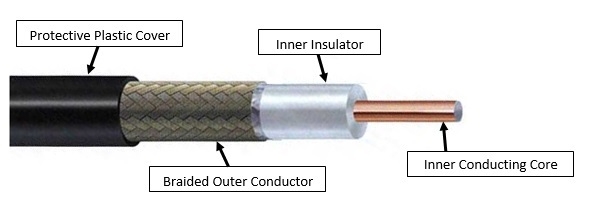
 Data Structure
Data Structure Networking
Networking RDBMS
RDBMS Operating System
Operating System Java
Java MS Excel
MS Excel iOS
iOS HTML
HTML CSS
CSS Android
Android Python
Python C Programming
C Programming C++
C++ C#
C# MongoDB
MongoDB MySQL
MySQL Javascript
Javascript PHP
PHP
- Selected Reading
- UPSC IAS Exams Notes
- Developer's Best Practices
- Questions and Answers
- Effective Resume Writing
- HR Interview Questions
- Computer Glossary
- Who is Who
Coaxial Cable
Coaxial cables, commonly called coax, are copper cables with metal shielding designed to provide immunity against noise and greater bandwidth. Coax can transmit signals over larger distances at a higher speed as compared to twisted pair cables.
Structure of Coaxial Cables
Coax has a central core of stiff copper conductor for transmitting signals. This is covered by an insulating material. The insulator is encased by a closely woven braided metal outer conductor that acts as a shield against noise. The outer conductor is again enclosed by a plastic insulating cover. The structure is shown in the following figure −

Categories of Coaxial Cables
Coaxial cables are categorized into three types as per radio government (RG) ratings −
- RG – 59: Has impedance of 75W and used in cable TV
- RG – 58: Has impedance of 50W and used in thin Ethernet
- RG – 11: Has impedance of 50W and used in thick Ethernet
Applications of Coaxial Cables
- In analog telephone networks: A single coaxial network can carry about 10,000 voice signals.
- In digital telephone networks: A coax has a data rate of 600 Mbps.
- In cable TV networks
- In traditional Ethernet LANs
- In MANs

Advertisements
